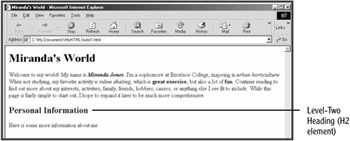 Debugger script
Dhtml css
Debugger script
Dhtml css
The H2 (Level-Two Heading) element is used to specify the major subheadings within a document. You will be creating a new section for the page that will feature a list of interests and other personal facts. Add a level-two heading to start this new section (see Figure 2.5):
<h2>Personal Information</h2> <p>Here is some more information about me:</p> </body>

Besides the H1 and H2 heading elements, which you have already used to add level-one and level-two headings to the page (defining a top-level heading and a major section heading), there are four additional heading elements that can be used—H3, H4, H5, and H6. The H3 (Level-Three Heading) element is used to specify minor subheadings, and the H4 (Level-Four Heading) element can be used to create a further level of subheadings. The H5 and H6 elements are rarely used, since they display by default in font sizes that are smaller than the default text size (used to display paragraph and other body text). An example page, headings.html, is included in the resources folder in your MyHTML folder that you can open in your browser to see what all of the heading elements look like (see Figure 2.6).
 Debugger script
Dhtml css
Debugger script
Dhtml css